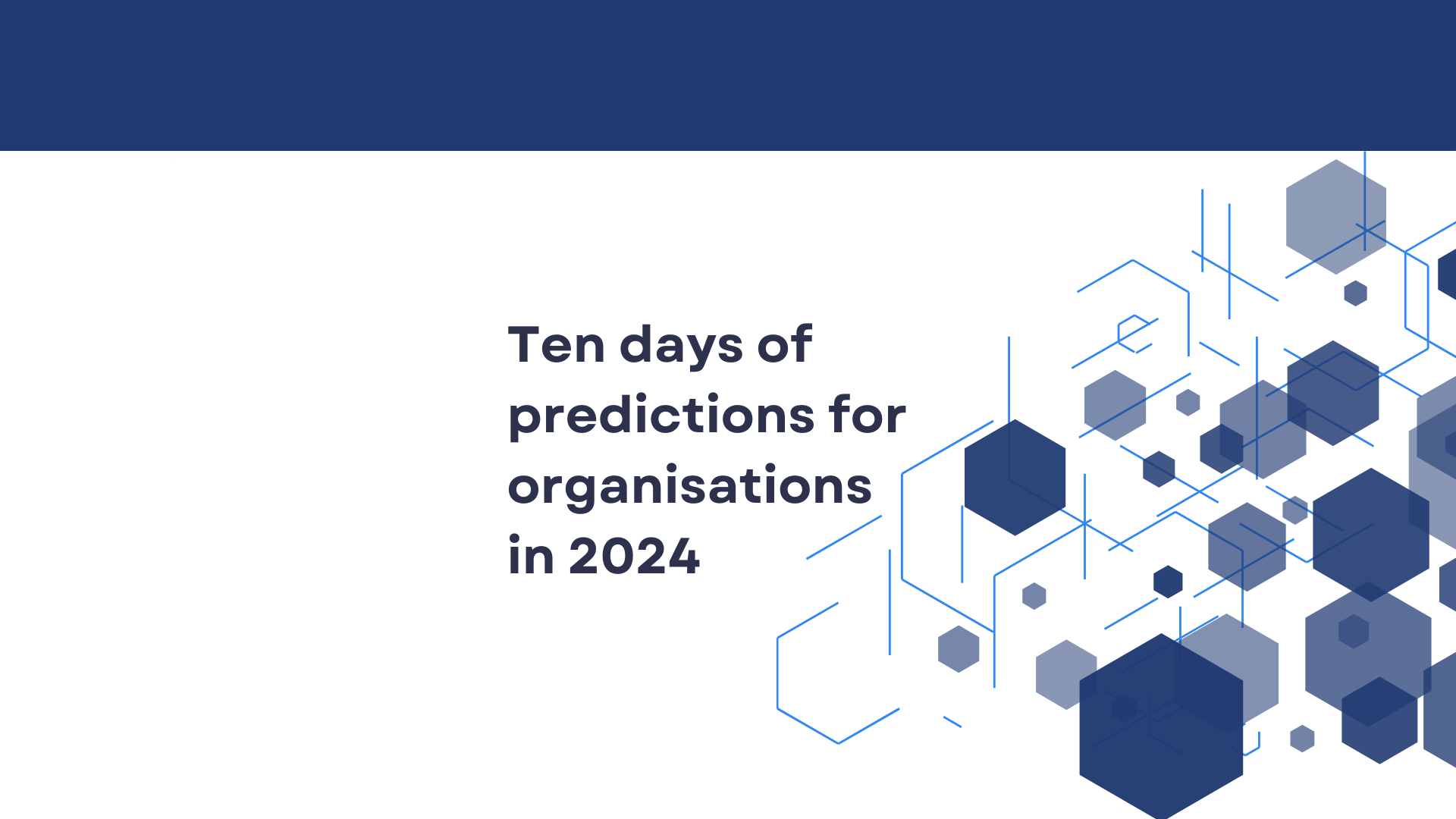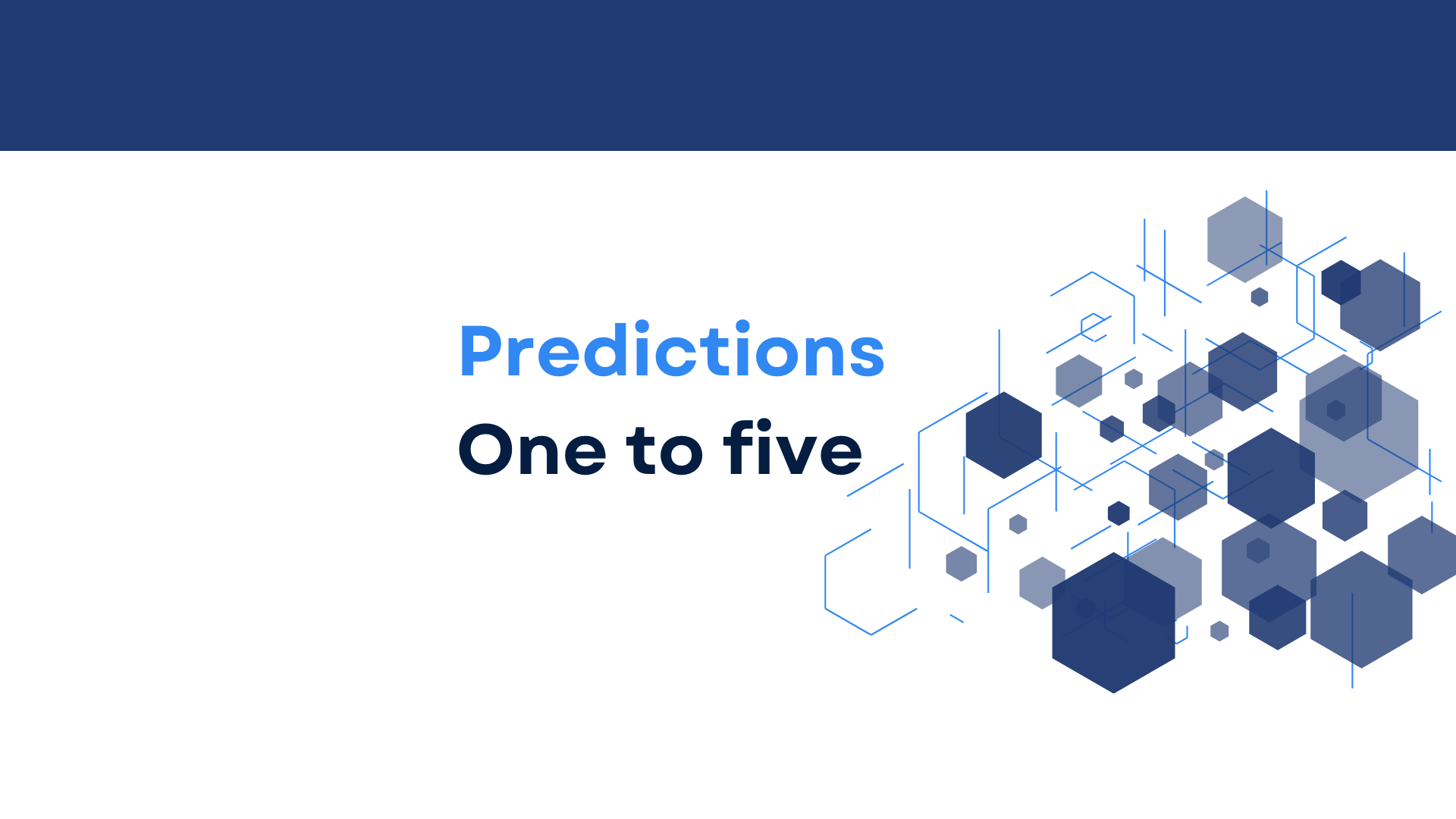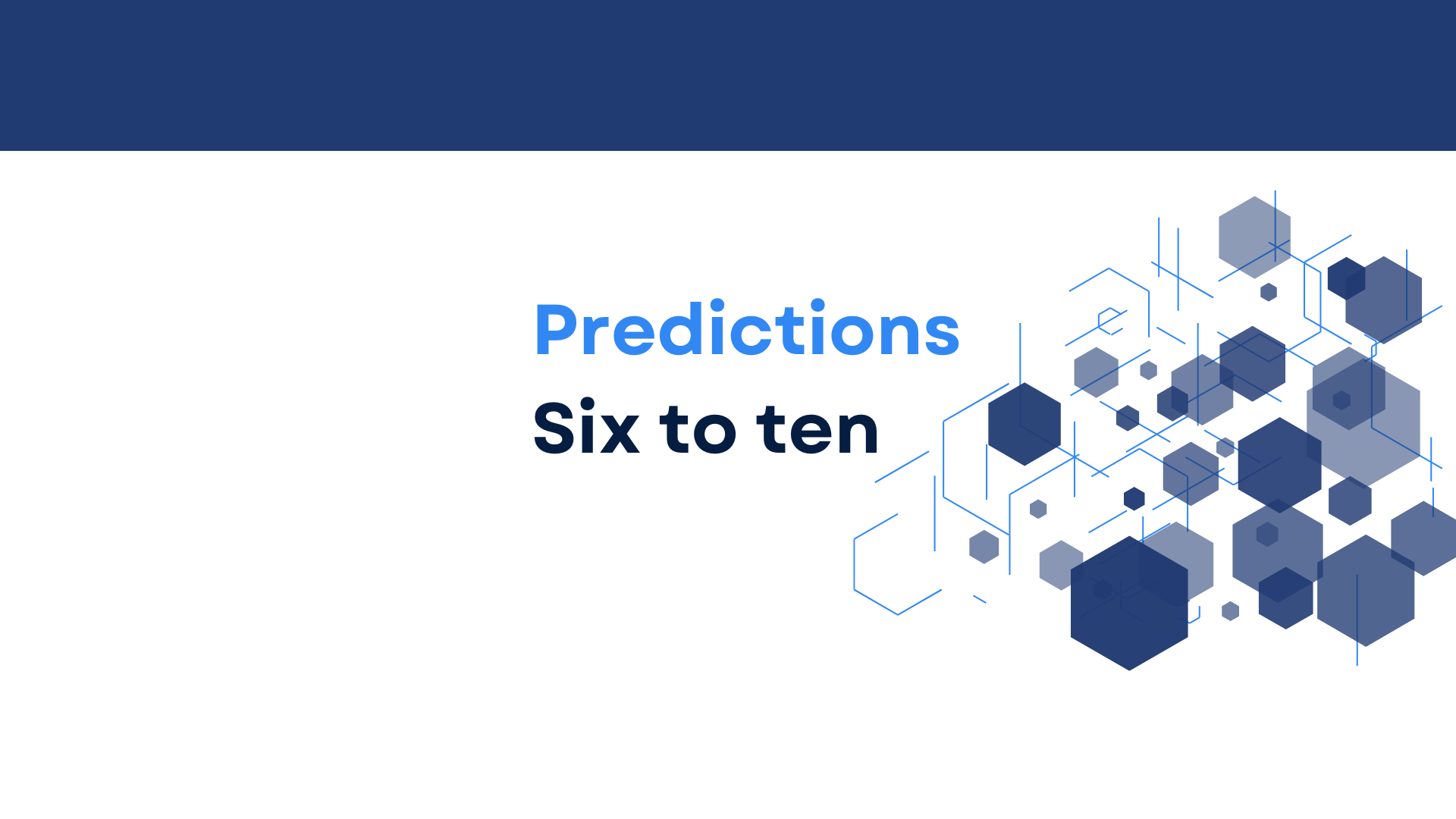
Last year in our predictions series, we reported on the key focus areas for public sector organisations in building resilient and future-fit governments through finding the right balance in managing change and strengthening culture, changing how employees work, and restoring and rebuilding citizen trust.
As we look to 2024 and beyond, there is an increased focus on leaders, how they lead, and the attributes that leaders must bring to empower their staff, manage their wellbeing, unite them in purpose, provide personal growth and career development, and encourage everyone in creating inclusive workplaces for all.
Additionally, the need for organisations to deepen their operational maturity and the management needed in the responsible adoption of new technologies will prove pivotal in 2024, with further exponential growth and use cases of generative AI predicted.
Without further ado, please see our full predictions lists below.

Prediction one: Integrity: The key attribute that leaders must bring to 2024
“Integrity requires action at all levels, but without the right tone and demonstration from the top there will be no lasting impact”. Source: Louder than Words: An APS Integrity Action Plan, November, 2023.
In the recent “Louder than Words: An APS Integrity Action Plan”, the Australian Public Service Commission (APSC) defines integrity as “doing the right thing at the right time” to “deliver the best outcomes for Australia sought by the government of the day.” The action plan examines three action areas: Culture; a focus on ethical leadership and rewarding the behaviours needed to serve the Australian community, Systems with a focus on making it easier for our people to do the right thing, and Accountability with a focus on improving knowledge-sharing, strategic cooperation and coordinated approaches to implementing integrity standards. The fourth culture recommendation of this plan, details a focus on ethical decision making and fostering psychological safety.
Cherie Canning, workplace expert and Founder and Director of Luminate Leadership, joined our podcast on organisational health and the seven dimensions of wellness earlier this year, where she provided a detailed explanation around the four stages of psychological safety as well as her perspectives on how leaders can create connections with their employees and turn toxic cultures around. This is essential listening to any organisational leader going into 2024. Our article “Human-Centred Design: The Key to Minimising and Preventing Psychosocial Hazards in the Workplace”, we also provide ways that leaders can identify, assess, and manage these risks through taking a Human-centred design approach.
Prediction two: Beyond 2024 – Organisations need to focus on long-term planning
The 2023 NSW Public Sector PMES Survey unfavourably revealed that only 39% of survey respondents felt that change was being managed well in their organisation, showing no improvement YOY in results. Further engagement results also showed that just over half of respondents felt that their organisation is making improvements to meet future challenges, and 58% felt supported through changes that affect their work.
During series one of our Trailblazing with CorbettPrice podcast on organisational health and the seven dimensions of wellness, we spoke to Scott Johnston, Deputy Secretary of Revenue NSW on the second dimension of organisational agility and resilience. During our conversation, Scott took us through how he and his team developed a ten-year strategy which involved extensive engagement and feedback from the entire workforce and how in doing this it drove deeper engagement and a sense of belonging.
With only 50% of employees in the PMES survey favourably responding to how Senior Managers provide clear direction for the future of their organisation, Scott’s lessons and advice remain essential as we go into 2024.
Prediction three: A team-of-teams approach is essential for 2024
According to 2023 PMES scores for the NSW Public Sector, 47% of respondents felt that people in their organisation took responsibility for their own actions, and 52% felt that their organisation generally selects capable people to do the job. According to global research conducted by The Josh Bersin Company in 2022, over 60% of organisations only rated their effectiveness in organisation design as low or moderate. The same report showed that the 11% of organisations who rated their organisational design as great, showed to be more agile and accountable. You can read more about this in our article, ‘Spending to save – six ways that BeHOLISTIC can help organisations reduce costs.’
One element of organisation design that we dived deep into across series one of our Trailblazing with CorbettPrice podcast on organisational health, was how we approached the structure of teams. In this conversation, we spoke with Rodger Watson, Senior Lecturer and Founding Course Director at the University of Technology in Sydney on how we could apply design thinking principles to improving the employee experience. During our chat, Rodger explained how taking a team-of-teams approach to organisation structure in comparison to a command-and-control approach predictably results in achieving outcomes, and how a team-of-teams approach can provide much more adaptive ways of working.
Prediction four: Changing scope – new focus areas for L&D in 2024
Whilst 64% of respondents in the 2023 PMES scores for the NSW Public Sector noted that they had received the training and development that they needed to do their job well, the percentage dropped to 50% for satisfaction with the opportunities available for career development in their organisation and 53% for their organisations commitment to developing its employees respectively. With a lack of future career opportunities still ranking as the primary reason for employees to leave their organisation, workforce development leaders must continue to prioritise how they can development the careers of their staff or continue to risk losing them.
Certainly L&D programs and career development is multifaceted with many elements to consider. One of these is internal mobility – providing employees with broader experience with some disciplinarian expertise. We spoke about how leaders can craft mobility into the employee experience with Rodger Watson, Senior Lecturer and Founding Course Director at the University of Technology in Sydney in episode four of our podcast series earlier on organisational health and the seven dimensions of wellness.
Another area to consider is encouraging personal growth, which we spoke about with David Powell, Author, founder, and life skills mentor of The Golden Thread in our seventh episode within our organisational health series, in expanding L&D programs to improve wellbeing and mental health and providing ways to help employees connect with their personal sense of purpose.
And a third strategy career development and advancement is providing public sector employees with home-based training solutions that provide hands-on, practical and real-life activities that employees can take back and apply immediately in their roles. Elevate by CorbettPrice offers a public sector certificate in Strategic Thinking and Execution, providing public sector executives with skills needed in developing and implementing a strategy and to understand how business transformation is delivered.
Prediction five: Organisations must increase their efforts in reducing employee burnout
Burn out continues to be prevalent across organisations, and the need to improve how organisations support their employee’s wellbeing remains essential going into 2024. 2023 PMES scores for the NSW Public Sector revealed that 34% of employees disagreed that they felt burnt out by their work. On the flip side, this means that 66% of employees feel burnt out. When looking at engagement drivers, 59% of employees were satisfied with current workplace practices to help them manage their wellbeing.
We spoke with workplace culture expert, Cherie Canning, the Founder and Director at Luminate Leadership, in our first podcast series on organisational health earlier this year, where Cherie shared her perspectives on how employers can support their employee’s mental health and provided examples of successful wellness initiatives that her clients have introduced for their employees.

Prediction six: Leading to empower employees in 2024
“We need to support leaders to respond effectively with curiosity, with empathy and without defensiveness”. Source: Louder than Words: An APS Integrity Action Plan, November, 2023.
Read through the recommendations and actions in the recent APS Integrity Action Plan, and you’ll see a repeated theme throughout; good leadership. So what is good leadership in the public sector, and more importantly, how can leaders empower their employees?
We invited Pia Andrews, public servant and global expert in open government and digital government transformation, to speak on the topic of purpose and leadership in our inaugural podcast series on organisational health and the seven dimensions of wellness. During our enlightening conversation, Pia shared her perspectives on the need for leaders to shift to adaptive leadership; servant leadership, and how this means to delegate down to teams, trusting them, buying into and understanding and valuing their internal expertise and bringing it into the room.
Pia also spoke of how critical a commitment to purpose and culture is and how a clear purpose unites a team and contributes to creating a culture that is committed to kindness, trust, mutual trust and calm. Her perspectives couldn’t be more accurate, with 2023 PMES scores for the NSW Public Sector revealing that only 50% of respondents felt that their senior managers provided a clear direction for the future of the organisation and only 46% felt that their senior managers listen to employees.
Listening is one of the most important things that any leader can do today. This is one of the jewels of advice that Daniel Bowes, Executive Director, NSW Department of Customer Service, imparted with us in episode two of our podcast series on embracing organisational change.
Integrity, purpose, trust, and listening are essential for leaders to empowering their teams in 2024.
Prediction seven: Operationally, organisations must grow up in 2024
“Adding intelligence to the journey – by applying a strategic approach to advancing the operating model and transforming the business through technology, processes and people – eases and speeds an organisation’s race to the top.” Source: Accenture, Fast-track to future-ready performance.
In prediction one of this series, we spoke about the need for organisations to be prepared to meet future challenges. Having a vision and long-term strategy is essential, as is an organisation’s operational maturity. In 2024, organisations need to go beyond achieving just stability with incremental changes and efficiency achieved through automation, and move into predictive and future-readiness embedding advanced data science, machine learning, cloud and AI, to truly transform and position them into the future. In Forrester Research’s 2024 Predictions: Exploration Generates Progress, they predict that generative AI is poised to increase productivity across IT operations, with current projects already citing software development task improvements by up to 40%. Not only will AI initiatives boost productivity, but the report also states that it will boost creative problem solving by 50% as well.
Prediction eight: The DEI essentials for 2024
“Only 20% of companies will fund a DEI function with an endorsed strategy and personnel – a 7-point drop from 2023 levels.” Source: Forrester Research’s 2024 Predictions: Exploration Generates Progress.
This ominous prediction looks at how focus and funding on developing the employee experience will take a nose dive into 2024, with heavy attrition rates also predicted amongst DEI leaders. Unfavourably, PMES 2023 NSW Public Sector results also indicated that over half of employees didn’t feel that their senior managers listen to all employees, or support the career development of all employees at 46% and 45% respectively.
Looking at selected demographics of non-binary employees, and people with a disability specifically, they consistently show at least 5 percentage points lower than the report unit on key topics across wellbeing, role clarity and support, inclusion and diversity, learning and development and senior managers.
We spoke with Julie Etchells, Chief Human Resource Officer with the Department of Children, Youth Justice and Multicultural Affairs for the Queensland Government in episode three of our second podcast series on embracing organisational change about ways that everyone can help to create inclusive workplaces where everyone feels valued, their differences are recognised, and they are seen as a positive contributor to the organisation.
Prediction nine: Getting hybrid working and WFH right in 2024
“I think there will be a greater call for more and more flexibility though moving forward and it's something that the sector will need to grapple with.” Tina McAllister, Acting Director for People and Culture at the Department of Agriculture and Fisheries for the Queensland government.
According to Forrester Research, The Netherlands leads the European continent in its support for flexible working, with 74% of workers allowed to work remotely in 2023. Back at home here in Australia, that number is 26%.
There are many discussions (and debates), on what the right balance is, and arguably every situation is different so there is no ‘one size fits all’ approach available. Across our two podcast series, we’ve spoken to several practitioners on this topic, covering off examples of what the Queensland government have implemented in their FlexConnect framework during our conversation with Tina McAllister, Acting Director for People and Culture at the Department of Agriculture and Fisheries, and also from a workplace cultural perspective with Cherie Canning, Founder and Director of Luminate Leadership, on how leaders can help their remote employees feel connected to culture.
Prediction ten: The ‘must-win’ in AI for 2024
We have all heard, seen and discovered the benefits and developed use cases for generative AI for ourselves, both personally, and in a business context, throughout the past year. 2024 definitely won’t be any different in terms of the exponential growth and use cases for generative AI. Forrester Research predicts that “Generative AI will be the fulcrum that businesses rely on to enhance, empower, and engage employees and customers” in their recent 2024 predictions report.
Whilst we can see the reported benefits across many facets of generative AI such as boosting productivity and creative problem-solving, as well as promising improvements in delivering to customers, what about guidance on where to not use it?
Pia Andrews, public servant and global expert in open government and digital government transformation, joined us to talk about this very topic in episode five of our second podcast series on embracing organisational change. During our discussion, Pia detailed the gap that she saw in terms of having practical guidance on where not to use AI and how a whole of management approach is needed to detect, monitor for, and intervene, when the system is going in the wrong direction. Pia also detailed why she wrote the Trust Framework for the Government Use of AI and ADM and ran through the the six major questions that we organisations need to be able to answer when they are trying to design for trust.

Taking action in 2024
We hope that you have enjoyed reading our predictions series and are encouraged to move forward confidently into 2024. If, in reading our series, there are key areas that stood out to you that you would like to explore further, please get in touch with us, or find out more about us here.


